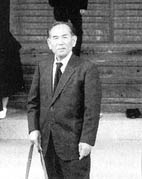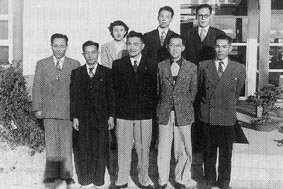My Life at ABCC-RERF
by Motokazu Yamagata
Department of Research Support, 1948-80

Motokazu Yamagata
t was our important duty as field investigators to visit the homes of atomic bomb survivors, using the supplementary survey of the 1950 National Census, to interview these people and to fill out questionnaires (RQ) about their radiation-related problems. Before making the regular survey, we received several forms to try it out in the Ujina area. Gaining confidence, we were able to complete 35 sheets a day thereafter, and the survey proceeded smoothly. Our subjects included also those people who made their living on the water and those institutionalized in orphanages, etc. As it was our first experience in interviewing people, we had to do this with the greatest possible care.
In this survey, we visited the City Hall and its branch offices, homes of heads of town associations, homes of welfare commissioners, and police boxes for information concerning the whereabouts of certain families. We received much cooperation from these quarters.
Before long, offices of ABCC were opened in six localities in the city, in Chuo (central part of the city), Koi, Kyobashi, Funairi and Oko and later in Kako-machi, and I was assigned from July 1953 to March 1957 as chief of the Koi Office which was responsible for the west area of the city. This neighborhood, which had been known for its many landscaping companies, was affluent and its recovery from the A-bombing appeared to be quick because it was somewhat removed from the hypocenter. From the head office, which was then in the Gaisenkan building in Ujina, cards were delivered to each local office (6-10 members in each) and the office chief passed these out to the staff, who went out on their bicycles to investigate. About that time it was also decided to start a birth survey, so we also visited the homes of midwives. This survey, which was completed through the kindness and cooperation of the people of the community, was the basis for the later PE-18, PE-86 and F1 studies.

Members of questionnaire survey team in Koi Office.
Closing of the local offices began as the end of the RQ survey approached, and we all moved to Hijiyama in 1957. The Master Sample Questionnaire survey was initiated and 50-60 investigators visited the homes of A-bomb survivors by area and carried out interviews. The survey, making combined use of 60 jeeps and bicycles, was made at great length, covering areas from Kaita to Itsukaichi, and extended even to the Iwakuni area. Nearly 10 homes were visited in a day. This MSQ survey, like the RQ survey, was an important survey and became the basis for the present ST100 and ME200 studies.
Later, in 1959, the importance of improving the efficiency of the contacting work and introducing a sociological viewpoint in this work was recognized, and the Medical Sociology Department was established. We learned the techniques of counseling from our department chief, Dr. Matsumoto, and participated in lecture meetings and study and training meetings sponsored by the Medical Social Work Group. The opportunity to study in this way was very significant in that it provided useful knowledge for the performance of our work and was also appreciated by the A-bomb survivors.
Kaleidoscopic recollections of my life at ABCC-RERF, which greets its 40th anniversary this year, run across my mind. I extend cordial wishes for the continued prosperity of the Foundation and for the peace of mankind.
This article was originally published in RERF Newsletter 14 (40th anniversary special issue):73-74, 1988.

